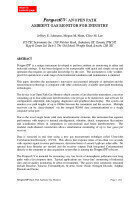Air monitoring
PerspectUV- AN OPEN PATH AMBIENT GAS MONITOR FOR INDUSTRY
Oct 06 2014
Author: Jeffrey E. Johnston, Megan M. Hunt, Clive M. Lee on behalf of CEM

Free to read
Articles are free to download. Please login to read this article or create an account.
ABSTRACT
PerspectUV is a unique instrument developed to perform ambient air monitoring in urban and industrial settings. It has been designed to be transportable with quick and simple set-up and operation that requires no specialist knowledge by the user. The instrument is fully weatherproof for operation in a wide range of environmental conditions and maintenance is minimal.
This paper describes the instrument’s innovative and patented principle of operation and the measurement technology is compared with other commercially available open path monitoring technologies.
The device is an Open Path Gas Monitor which consists of an ultraviolet transmitter, a receiver containing up to four solid state interferometers (one per gas to be monitored) and software for configuration, alignment, data logging, diagnostics and graphical data display. The system can monitor over path lengths of up to 1000m between the transmitter and the receiver. Multiple receivers can be ‘daisy-chained’ via the integral RS485 data communications to a single computer serial port.
Due to the novel single beam solid state interferometric elements, this instrument has superior performance with respect to internal misalignment, vibration, shock, temperature fluctuations and scintillation effects in comparison to conventional dual beam interferometers. The modular multi-channel construction allows simultaneous monitoring of up to four gases per receiver.
Data is extracted in real time using a new gas measurement technique called Ultraviolet Correlation Interferometry (UVCI). This allows fast response times of less than two seconds with superior signal-to-noise performance, detection limits of around 1ppb are achievable. No spectral data libraries are needed and the receiver outputs Path Integrated Concentrations directly to the computer or data acquisition system that is running the PerspectUV software.
The PerspectUV is intended for measuring very low levels of atmospheric pollutants over long paths with a fast response time. Typical applications are ‘fence-line’ monitoring of industrial sites and air quality monitoring in urban environments. The gasses most commonly measured include Benzene, Toluene, Formaldehyde, Styrene, Nitric Oxide, Nitrogen Dioxide, Sulphur Dioxide and Ozone.
INTRODUCTION
Open path monitoring is an efficient technique for ambient gas monitoring where a large area must be covered. There are two main advantages of open path monitors in comparison to point source monitors. Economically, an open path system can replace a number of point source monitors. Physically, open path data is a more representative measurement than point source data because it samples a line integral through the atmosphere.
An open path gas monitor is very similar in principle to a laboratory spectrophotometer. A spectrophotometer analyses a sample by looking at its light absorption signature to determine how much of a given chemical is present. An open path monitor operates in the same manner except that the “sample cell” is a section of atmosphere, usually between 10 m and 1000 m in length. A system may consist of a transmitter and receiver located a distance apart (bistatic configuration), or a combined transceiver with a remotely located retro-reflector (monostatic). The measured quantity is the path-integrated concentration, hence the long lengths of their paths make these instruments very sensitive to low average concentrations. Typical minimum detection limits (MDL’s) are in the low part per billion (ppb) range for a 500 m path.
A detailed review of open path instrumentation is found elsewhere (Sigrist, 1994). This work focuses on the application of a different type of technology that is newly available in the market-place.
The technology used for spectral instrumentation is usually dependent on the observed region of the spectrum. Ultraviolet (UV) or visible instrumentation is predominantly dispersive, using an optical element such as a diffraction grating or prism to spatially separate the spectral information. In contrast to interferometric systems, the advantage of dispersive systems is that they are easy to construct and to keep aligned due to relaxed optical tolerances.
Infrared systems are typically Fourier transform Infrared (FTIR) spectrometers. FTIR spectrometers acquire data with an interferometer, and convert this data to a spectrum by using a Fourier transform. Because infrared detectors are governed by a thermal noise baseline, there is a great signal to noise advantage in performing interferometry as opposed to dispersing the light (Griffiths, 1986).
The PerspectUV ultraviolet interferometer system was created to circumvent the stability and internal alignment problems of conventional Michelson-type interferometers through the use of a solid state interferometric element. By using correlation interferometry, data is taken in real time with a large signal to noise advantage over Fourier transform spectroscopy. The result is a stable instrument with a fast response that is well suited to an industrial environment.
This paper describes the technology behind the design and operation of the PerspectUV. Ivanov (1996) discusses results of an intercomparison with point source monitors.
Digital Edition
AET 28.4 Oct/Nov 2024
November 2024
Gas Detection - Go from lagging to leading: why investment in gas detection makes sense Air Monitoring - Swirl and vortex meters will aid green hydrogen production - Beyond the Stack: Emi...
View all digital editions
Events
Jan 20 2025 San Diego, CA, USA
Carrefour des Gestions Locales de L'eau
Jan 22 2025 Rennes, France
Safety, Health & Wellbeing LIVE
Jan 22 2025 Manchester, UK
Jan 25 2025 San Diego, CA, USA
Jan 29 2025 Tokyo, Japan














